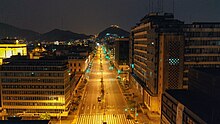Avenida Abancay
 Nighttime view of the avenue. The Public Ministry Building can be seen to the right. | |
| Part of | Damero de Pizarro |
|---|---|
| Namesake | Abancay |
| From | Puente Ricardo Palma |
| Major junctions | Jirón Amazonas, Jirón Áncash, Jirón Junín, Jirón Huallaga, Jirón Ucayali, Jirón Santa Rosa, Jirón Cuzco, Jirón Puno, La Colmena |
| To | Miguel Grau Avenue |
| Construction | |
| Completion | 1535 |
Abancay Avenue (Spanish: Avenida Abancay), formerly known as Jirón Abancay, is a major avenue that serves as the limit between the Damero de Pizarro and Barrios Altos, both located in the historic centre of Lima, Peru. The street starts at the Puente Ricardo Palma and continues until it reaches Grau Avenue.
Formerly a street (jirón), it was widened in 1947 under the government of Manuel A. Odría and buildings were built to house the ministries of economy and education. It is currently the second most congested artery in the city due to the circulation of 43 public transportation routes, in addition to private transportation.[1] This makes it one of the roads with the greatest environmental and noise pollution in the city.[2]
History[edit]
The road that today constitutes the street was laid by Francisco Pizarro when he founded the city of Lima on January 18, 1535. In 1862, when a new urban nomenclature was adopted, the road was named jirón Arequipa. Prior to this renaming, each block (cuadra) had a unique name:
- Block 1: Juan de la Coba, after the man of the same name who lived there in the 17th century.[3]
- Block 2: Trapitos, for reasons not known.[4]
- Block 3: Compás de la Concepción, after the part of the convent of the same name not yet built, known as a compás.[5]
- Block 4: Cascarilla, after the antifebrifuge bark of the same name sold by the Jesuits.[6]
- Block 5: Santa María, after the title of the noble family that lived there.[7]
- Block 6: Sagástegui, possibly also "Sagasti" or "Zugasti" after people who possibly lived there.[8]
- Block 7: Pileta de Santa Teresa, after the church of the same name. The area's appearance was heavily affected by the widening programme.[9]
- Block 8: Hospicio de Cándamo.[10]
- Block 9: Zepita.[11]
With the street widening programme in the 20th century, new blocks were created along the avenue.
- When the avenue was expanded to the north, through the Convent of San Francisco, the current first block was created.
- When the eastern section of Nicolás de Piérola Avenue (known as Colmena Izquierda) was created, Hospicio de Cándamo Street was divided, forming the current block 10 of the avenue.
See also[edit]
References[edit]
- ^ Rodríguez, Sabrina (2013-02-21). "¿Cuáles son las avenidas más saturadas de Lima?". Publimetro. Archived from the original on 2015-04-02.
- ^ "La avenida Abancay excede casi 5 veces límite de contaminación". El Comercio. 2006-05-24. Archived from the original on 2007-09-27.
- ^ Bromley 2019, p. 278–280.
- ^ Bromley 2019, p. 408.
- ^ Bromley 2019, p. 239.
- ^ Bromley 2019, p. 229.
- ^ Bromley 2019, p. 395.
- ^ Bromley 2019, p. 378.
- ^ Bromley 2019, p. 64.
- ^ Bromley 2019, p. 105.
- ^ Bromley 2019, p. 327.
Bibliography[edit]
- Bromley Seminario, Juan (2019). Las viejas calles de Lima (PDF) (in Spanish). Lima: Metropolitan Municipality of Lima. Archived from the original (PDF) on 20 April 2020.
